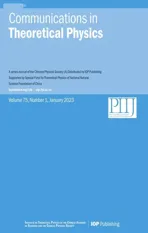Thermoelectric transport in holographic quantum matter under shear strain
2023-02-16TengJiLiLiandHaoTianSun
Teng Ji ,Li Li,3,4,∗ and Hao-Tian Sun
1 CAS Key Laboratory of Theoretical Physics,Institute of Theoretical Physics,Chinese Academy of Sciences,Beijing 100190,China
2 School of Physical Sciences,University of Chinese Academy of Sciences,No.19A Yuquan Road,Beijing 100049,China
3 School of Fundamental Physics and Mathematical Sciences,Hangzhou Institute for Advanced Study,UCAS,Hangzhou 310024,China
4 Peng Huanwu Collaborative Center for Research and Education,Beihang University,Beijing 100191,China
Abstract We study thermoelectric transport under shear strain in two spatial dimensional quantum matter using the holographic duality.General analytic formulae for the DC thermoelectric conductivities subjected to finite shear strain are obtained in terms of black hole horizon data.Off-diagonal terms in the conductivity matrix also appear at zero magnetic field,resembling an emergent electronic nematicity,which cannot nevertheless be identified with the presence of an anomalous Hall effect.For an explicit model study,we numerically construct a family of strained black holes and obtain the corresponding nonlinear stress–strain curves.We then compute all electric,thermoelectric,and thermal conductivities and discuss the effects of strain.While the shear elastic deformation does not affect the temperature dependence of thermoelectric and thermal conductivities quantitatively,it can strongly change the behavior of the electric conductivity.For both shear hardening and softening cases,we find a clear metal-insulator transition driven by the shear deformation.Moreover,the violation of the previously conjectured thermal conductivity bound is observed for large shear deformation.
Keywords: black hole,transport property,gauge-gravity duality,condensed matter,shear strain
1.Introduction
The transport coefficients characterize the intrinsic properties of a system and are fundamental for understanding the transport phenomena that are ubiquitous in nature.For example,the electric or thermal conductivities are associated with the conduction of a system due to the electric or heat current.Other transport coefficients,such as the shear and bulk,viscosities are related to the resistance of a system under the shear and tensile stress.While these coefficients could be quantitatively obtained in experiments,it is usually challenging to obtain them from first-principles calculations.Thanks to the development of holographic duality,the transport coefficients of strongly coupled systems can be easily computed by analyzing small perturbations about their dual black holes.The most famous example is a universal ratio between the shear viscosity and the entropy density,known as the Kovtun–Son–Starinets bound [1].Interesting applications of holography can be found,e.g.in some recent reviews [2–8].
The study of the transport behaviors from holography has attracted much attention in connection to the ‘anomalous’experimental observations in quantum matter (e.g.strange metals [9–14]).Although most works have concentrated on cases in the absence of mechanical deformation,stress/strain effects could be the most obvious way to statically or dynamically tune transport.From a microscopic perspective,stress/strain directly induces lattice deformation and modulates phonon propagation,thus could significantly affect material properties(electrical,optical,mechanical,and so on).Strain engineering is now recognized as a promising approach to generating novel effects in graphene and other twodimensional materials [15].It has also been widely used as a common tool in amorphous systems[16].Moreover,there is a growing interest related to the nonlinear mechanical characterization of high-temperature superconductors (see,e.g.[17–20]).In holography,the nonlinear mechanical response was first introduced in[21],where the nonlinear stress–strain curves,as well as an estimate of the elasticity bounds in the elastic regime,were discussed.More recently,based on the effective field theory and holographic duality,a potential relationship among the nonlinear elasticity,yielding and entropy of granular matter was suggested and then verified by computer simulations of granular models [22].The thermodynamic and mechanical properties of a holographic bottomup model for the supersolid were considered in [23].Interestingly,shear flows in some holographic models were investigated in [24] where the viscosity-entropy density ratio shows some universality even far away from equilibrium.5See also [25] for the oscillatory shear tests in a holographic model with finite elastic response in the large amplitude oscillatory shear regime.
For a strongly coupled system at finite temperature,T,and charge density,ρ,its response to the application of an electric fieldEiand a temperature gradient ∂iTis characterized by the thermoelectric transport coefficients in linear response:

whereJiis the electric current andQiis the heat current.Herei,jrefer to space indices and the sum over repeated indices is understood.In the above expression,the matrix σ is the electrical conductivity,α andare the thermoelectric conductivities andis the thermal conductivity.Moreover,when the system respects time-reversal symmetry,the Onsager reciprocal relation yieldsα=.To have a finite DC conductivity that is crucial for describing real materials,a mechanism for momentum dissipation is necessary.It is remarkable that an analytic expression for the DC conductivity can be obtained in terms of black hole horizon data[26,27].The simplest and most convenient way to realize the momentum dissipation in holography is the so-called linear axion models [28] (more details and generalizations can be found in a recent review [29]).
As an initial study of holographic transport subject to nonlinear mechanical strain,we focus on the transition between metallic and insulating behavior in the present work.As a fascinating and enduring area of study in condensed matter physics,the understanding of metal-insulator transition(MIT) is still controversial and incomplete (see e.g.[30,31]for reviews).A minimal holographic setup in two spatial dimensions was given in [32,33] where the DC electric conductivity was shown a transition from metallic to insulating behavior driven by disorder.Moreover,the magnetotransport was then discussed and the temperature dependence of resistivity was found to be well-scaled with a single parameter [34],which agrees qualitatively with the experimental observation in the literature.We shall extend previous studies to the full thermoelectric conductivities(1)and turn on the nonlinear shear strain.In particular,we shall show how the effect of mechanical deformation on the thermoelectric transport for a strongly coupled system that allows a holographic dual description.We will find that there are non-vanishing off-diagonal components of conductivity tensors even in the absence of a magnetic field.We will show that this phenomenon bears no relation with the anomalous Hall effect,but is a manifestation of a strong electronic nematicity due to the strain-induced anisotropy.Moreover,the electric conductivity will be shown to be sensitive to shear deformation.For both shear hardening and softening cases,we will observe a clear transition between an insulating phase and a metallic phase by increasing the strength of mechanical deformation.This transition will be shown to be closely associated with electronic nematicity and pressure anisotropy.Interestingly,we will find that the previously conjectured thermal conductivity bound[35]can be violated by increasing the shear deformation.
The organization of this paper is as follows.In section 2,we introduce the holographic setup.We derive the general formulae for the DC electric,thermoelectric,and thermal conductivities at finite elastic mechanical deformation in section 3.In particular,we classify the physical origin of the off-diagonal components of thermoelectric transport.In section 4,we illustrate two kinds of behaviors under shear deformation,i.e.shear hardening and softening.In section 5,we study in detail the effect of shear deformation on DC transport.We conclude with further discussions in section 6.The holographic renormalisation procedure is performed in detail in appendix A.The electric transport under shear strain by dialing the charge density is summarized in appendix B.
2.Holographic model
We consider the following holographic model in four dimensions

where Λ is the negative cosmological constant andFμνthe field strength for theU(1)gauge field encoding the charge degrees of freedom.There are two sets of massless scalar fields φIand φI(I=1,2) known as holographic axions (see [29] for a recent review).The former provides a mechanism for momentum dissipation,while the latter for elastic mechanical deformation.YandVare functions of the translation-breaking sectorX0≡The precise form of mechanical deformation is determined by the potential termW(X,Z) where XIJ≡andZ≡det(XIJ).6The idea of splitting explicit and spontaneous symmetry breaking using two sets of scalars was discussed,e.g.in [36,37].
The general equations of motion are given by

To study the system at finite mechanical deformation and charge density,we take the following bulk geometry.

Here the constantkcaptures an averaged description of disorder strength coming from a homogeneously distributed set of impurities [32].The parameter β corresponds to the bulk deformation and the parameter Ω to the shear deformation ε via7From an effective field theory point of view,the general mechanical deformation can be parameterized by the matrix [38] with the two parameters β and ε directly related to a background bulk strain and a background shear strain.β controls the change of volume in the system,while ε implements a pure shear.

Unsheared configurations correspond to Ω=0.The holographic coordinateuspans from the AdS boundaryu=0 to the black hole horizonu=uhwheref(uh) vanishes.The temperature and entropy density of the background geometry(6) is given by

Substituting the ansatz (6) into(3),we obtain the following equations of motion
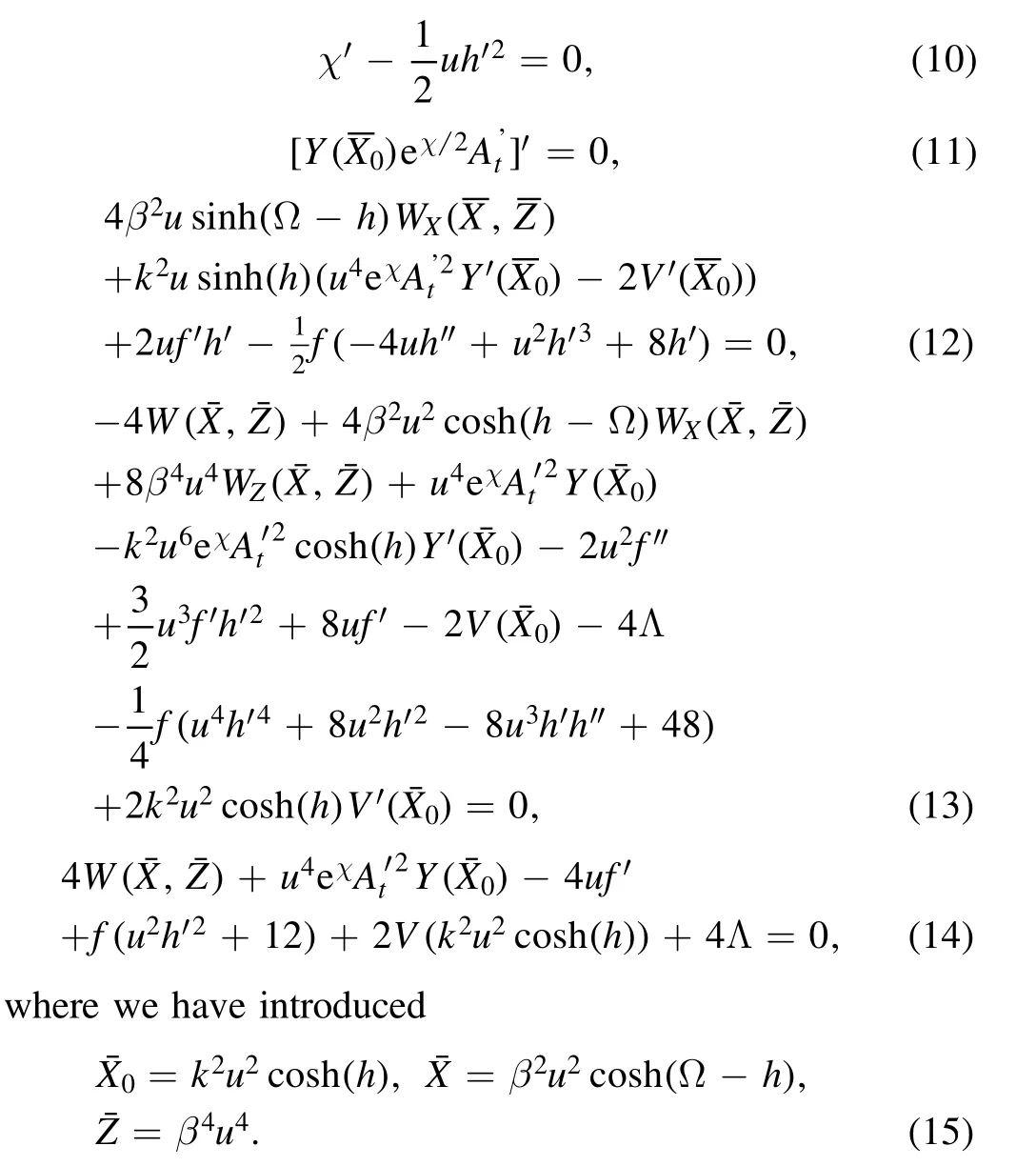
We point out that the last equation of motion(14) is a first order one and can be derived from other equations.
In the absence of mechanical deformation,the above equations of motion can be solved analytically.For the case with finite shear strain/stress,one has to solve the coupled system(10)–(14) numerically.When solving the above equations,we impose the regularity condition at the horizonu=uhwheref(uh)=At(uh)=0 and bothh(uh) and χ(uh) are finite.At the UV boundaryu=0,we have

where dots represent higher powers ofu.Note that the time scale of the time coordinate is fixed by requiring χ(u=0)=0 such that the temperature at the UV boundary is equal to the standard Hawking temperature(9).We identify μ and ρ to be the chemical potential and the charge density of the boundary system,respectively8Without loss of generality,we have required Y(X0)=1 at the AdS boundary u=0..From the Maxwell equation (11),there is a conserved charge in the radialdirection

which can be evaluated at any value ofuincludingu=uh.
The constantsf(3)andh(3)correspond to the energy density and shear stress,respectively9The asymptotic expansion of h(u) near the boundary u=0 reads where h(0) is identified with the source of the stress tensorxy and h(3) is related to the expectation value ofxy.We turn off the sources of spacetime deformation,i.e. h(0)=0,so the only possible source for the stress tensor is from the mechanical strain deformation encoded in the scalars φI.

3.Computation of transport coefficients
Holography provides an elegant prescription for calculating transport coefficients of strongly coupled systems.In particular,there are analytic formulas for DC conductivities in terms of black hole horizon data [26,27].To study the transport properties of the dual system we apply this method to our theory at finite shear deformation.In particular,we will classify the physical origin of the off-diagonal components of the thermoelectric transport induced by shear strain.
3.1.Conductivities from black hole horizons
We turn on small perturbations around the background(6)11From the Ward identity(70) in appendix A,one can check that the momentum does dissipate at the level of fluctuations due to the contribution of φI.

wherei=x,y.Eiis the electric field and ζiis identified as the temperature gradient of the boundary theory,i.e.ζi=-∂iT/T.The next key ingredient is to introduce the following bulk currentsJiandQi

where ξμis chosen to be the Killing vector field ∂t.Evaluating them at the UV boundary,one can find that they are,respectively,the electric current and heat current of the dual field theory.Moreover,one can verify that both currents are radially conserved,i.e.∂uJi=∂uQi=0 by substituting into the equations of motion(3).Therefore,they can be calculated anywhere in the bulk.The strategy is to evaluate them at the event horizonu=uh,where δgti,δφi,δφiare finite and δgiucan be expressed by the constraint of regularity.More precisely,one has the following relation for perturbations nearuh

Inserting(21) and evaluating at the horizonu=uh,both currents in(20)are thus given by their values at the black hole horizon,which in turn are fixed byEiand ζi12One also needs to express hiu(u) in terms of Ei,ζi as well as background fields by using Einstein’s equation..
Finally,we are able to obtain all DC conductivities via(1).More explicitly,with the notation

the general DC conductivity formulae are given as follows.
• The electric conductivity tensor σ with

• The thermoelectric conductivity tensor α with
• The thermal conductivity tensorwith

All functions in the above expressions will be understood to be evaluated at the horizonu=uh.We have also used(9)and(17) forT,sand ρ.
It is manifest that,in the linear response regime,the conductivity tensors(σ,α,)can be fully determined by the horizon data of the background solutions.Note that there is a simple relation betweenand α that is given by

irrespective of the model details.By turning off the mechanical deformation,we obtain the following unstrained results:

with all off-diagonal components vanishing.As a consistency check,the DC conductivity precisely recovers the result in[32,34,39] whenW=0.
3.2.Origin of the off-diagonal components
We obtain the finite off-diagonal components of conductivities subject to finite shear strain in the linear response.Thus,a natural question is the physical origin of such offdiagonal components.
Let’s focus on the electric conductivity for which we have a symmetric part σxy=σyx.The symmetric part of the off-diagonal conductivity tensor was identified as anomalous Hall conductivity in [40].Nevertheless,we should point out that Hall conductivity necessarily requires the breaking of time-reversal symmetry and is antisymmetric (σxy=-σyx) as a consequence of Onsager reciprocity relations13Note,however,that the nonlinear Hall effect can occur in systems with time-reversal symmetry [41]..Note thatα=(24) in our holographic model,thus respecting the time-reversal symmetry.Another way to understand the symmetric part of the off-diagonal conductivity tensor is as follows [42].Given that the system becomes anisotropic due to the shear strain(8).In the coordinate system ea,ebdefined by the principal axes (eigendirections) of the strain tensor(77),the electric conductivity tensor becomes diagonal

where the anisotropy is encoded in Δσ ≡(σa-σb)/2.Now we rotate the axes by an angle θ and measure the conductivity in this new coordinate.Then the conductivity matrix(28)changes accordingly and becomes

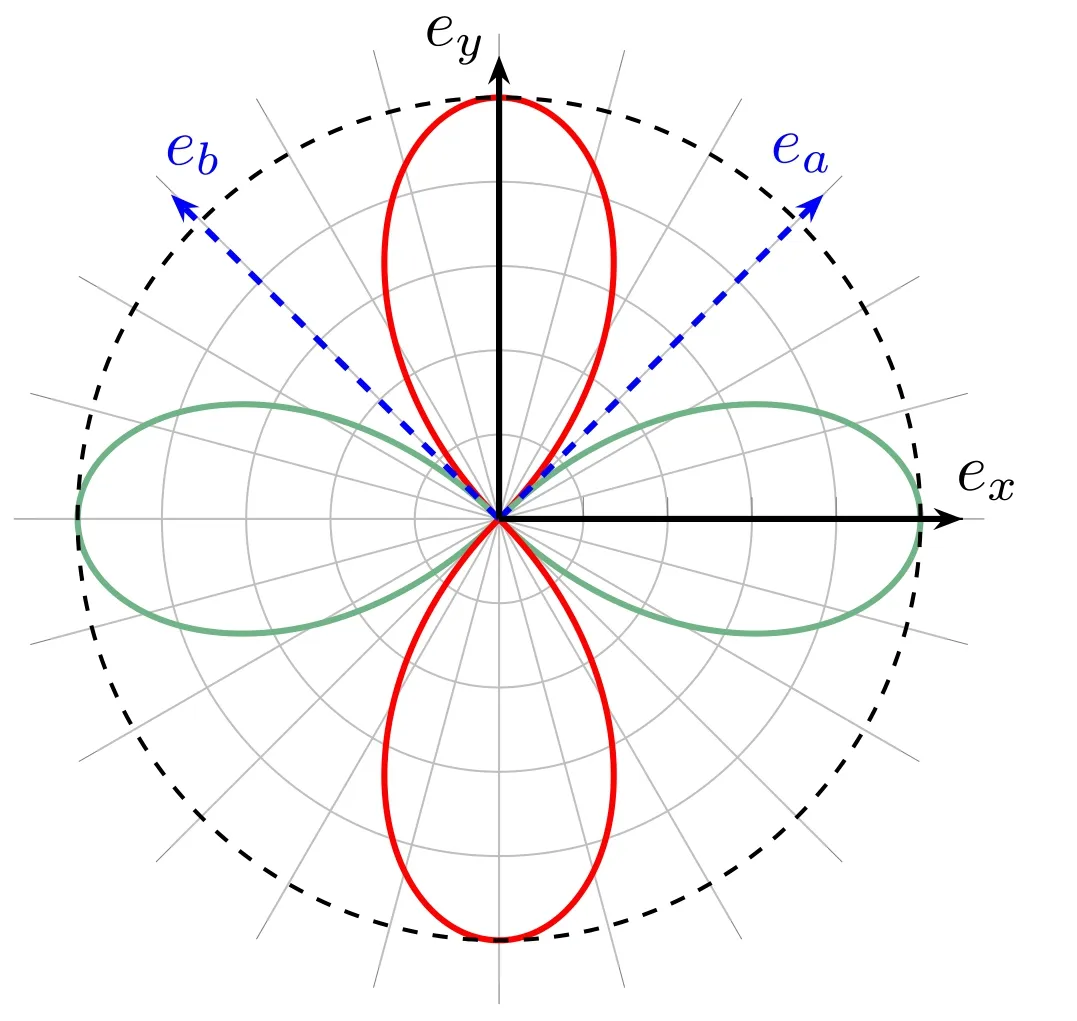
Figure 1.Illustration of the off-diagonal component of σ(θ) in polar coordinates.The radial distance measures its magnitude,with the positive values in red and the negative in green.The two solid dark arrows denote the unit vectors ex and ey along the x and y directions,while the dashed blue arrows correspond to the unit vectors ea,eb defined by the principal axes of the stress tensor(77).
It is now clear that there must occur a spontaneous transverse voltage once the current is not aligned with one of the principal axes.We show a polar-coordinate plot of σ(θ)xyin figure 1,where the ‘cloverleaf’ shape characteristic ofdorbital symmetry is manifest.
Note that all conductivities(23)–(25) are 2×2 real symmetric matrices.Therefore,they share the same eigendirections,where exand eyare,respectively,the unit vectors along thexandydirections of our original coordinate system(6).Meanwhile,the strain tensor(77) is diagonalized with the pressurealongebwhereℇand Σ are,respectively,the energy density and shear strain given in(18).It is now manifest thateaandebdefine the principal stress axes.
In our computation,we have forced the currents to flow along exand ey,see(19).Therefore,the rotation angle from eato ex(and,equivalently,ebto ey) is θ=-π/4.Indeed,by taking θ=-π/4,we can obtain our holographic results from(29)

with σxxand σxygiven in(23).It is clear that σxy=σyx.A similar discussion applies to α and.Motivated by the above observation,a good order parameter quantifying the anisotropy of the system is given by the (relative) magnitude:

that resembles a strong electronic nematicity in the system.
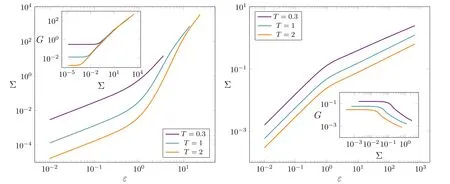
Figure 2.Illustration of shear hardening and shear softening.Left: stress–strain curves for W(X, Z)=X3.Right: stress–strain curves for W (X ,Z)=.Inset:the shear modulus G in the function of the shear stress.Different colors correspond to different temperatures.Other parameters are fixed to be β=k=ρ=1.
Before ending this section,we emphasize that σxyin our present theory occurs in zero magnetic fields,and is not connected to the Hall effect,skew spin scattering,Berry phase,loop currents,and so on [42].
4.Shear softening and hardening
As a key representation of the material deformation response,stress–strain curves reveal the relationship between the material structure and its mechanical properties.The stress–strain curve Σ(ε) could be easily measured by experiments while it is usually difficult to compute from the microscopic ingredients,especially in strongly coupled systems.Nevertheless,the nonlinear elastic response can be obtained using holographic methods,yielding a rich phenomenology of nonlinear elasticity behaviours,see e.g.[22–25].Given the full stress–strain curves,one can define the nonlinear elastic shear modulusG≡dΣ/dε.For sufficiently small strain,one recovers the standard linear elasticity relation Σ=G0ε whereG0is the linear shear modulus that can be computed by linear response theory.In the nonlinear regime,shear hardening corresponds to the case where the shear modulusGis positively correlated with shear stress,while the shear softening is evidenced by a rapid decrease of the shear modulus.
We are interested in the pure shear case,so we choose β=1 i.e.no bulk deformation14This fixes the scaling symmetry of our system and all physical quantities below are understood to be in units of β..In the following discussion,we shall focus on the following representative model with

A transition from metallic to insulating phases driven by charge density,disorder and magnetic field was found in the above model[34].The behavior of nonlinear elastic response is encoded in the potentialW(X,Z).To be specific,we take two benchmark models with monomial potentialsW(X,Z)=X3and.The stress–strain curves are shown in figure 2.In both cases,at small strains ε ≪1,the response is linear and the slope is given by the unstrained shear modulusG0.Moving away from the linear regime,the stress Σ increases monotonically with the strain ε.For the former potential,the shear modulusGincreases with the increase of ε,thus describing a shear hardening.In contrast,in the latter case,Gdecreases with the increase of ε,yielding shear softening.In a sense,it means that the softening material is less sensitive to the shear strain.
5.DC conductivity under shear strain
After the discussion on a class of models,we study in detail the DC conductivity under nonlinear shear strain.We will show the behavior of electric (σ),thermoelectric(α,α¯),and thermal() conductivities subject to mechanical response with both shear hardening and shear softening.Since we are mostly interested in the effect on the transport with applied shear strain,we mainly focus on the shear hardening case as the system is more sensitive to the shear strain,see figure 2.We will show that similar features still appear in the shear softening case.
Let us consider the transport behavior in the absence of strain/stress before proceeding.To be specific,we take the potentialW=X3and tune the disorder strengthkwith ρ=1,see(27).As can be seen from the left panel of figure 3,the temperature dependence of the electric conductivity σ0has a rich behavior.At strong disorder strengthk,σ0drops monotonically asTis decreased,characterizing an insulating behavior15We adopt a more realistic and phenomenological definition for an electric insulator that is basically dσ/dT>0 and for a metallic behavior by dσ/dT<0.A similar definition applies to both the thermoelectric and the thermal conductivities..In contrast,at weak disorder,σ0shows a nonmonotonic pattern.As the temperature is decreased,σ0first increases,exhibiting a metallic behavior,and then decreases.Nevertheless,there is a clear transition between the insulating and the metallic behaviors are driven by the disorder above a particular temperature.

Figure 3.Transport properties in function of T for various disorder strength k in the absence of shear strain.Left: Electric conductivity σ0.Center:Thermoelectric conductivity α0.Right:Thermal conductivity 0.We consider the shear hardening model W=X3.Other parameters are ρ=β=1 and ε=0.
For both the thermoelectric coefficient α0(center panel)and the thermal conductivity(right panel),one finds that they decrease monotonically by decreasingT,irrespective of the disorder strength.More precisely,we find the low temperature behaviors to be

withA0andK0two constants that depend onkand ρ.Therefore,the system at zero strain is a good thermal insulator.Moreover,by increasing the disorder strengthk,the amplitude of bothand α is suppressed,and both become less sensitive in the change of temperature.
In the following numerical calculations,we focus on the effect of shear deformation on the transport presented in figure 3.
5.1.Electric conductivity
We begin with the case at strong disorder for which the system at zero strain is a good insulator.The temperature dependence of the electric conductivity in the shear hardening case by dialing the shear deformation is presented in figure 4.It is clear that the off-diagonal component σxydevelops after turning on the shear deformation.Its amplitude increases with the deformation parameter(8).Meanwhile,with the shear strain increased,the temperature dependence of σxxchanges quantitatively.For small strain,σxx(T)is similar to the one without deformation(the left panel of figure 3).For sufficiently large shear deformation,there is a critical temperatureT0above which σxxbecomes a monotonically decreasing function ofTand below which σxxincreases asTis increased.Meanwhile,σxydevelops a dip atT0.One can see from figure 4 thatT0is not sensitive to shear deformation.Moreover,σxxat low temperature limit increases by increasing the shear deformation.Therefore,the insulating behavior will be destroyed,yielding a transition from an insulating phase to a metallic phase induced by applied stress.
In order to see the transition clearly,we consider the components of the electric conductivity along the principal axes,i.e.σaand σbof(28).In our present case,one has σa=σxx-σxyand σb=σxx+σxy.Note that σa≥σbas σxy≤0 (see figure 4).One can see from the right panel of figure 5 that σbhas a more rapid drop in temperature as the strain is increased,yielding a good insulating phase along theebdirection16Although σxx and σxy in low temperature limit are both monotonic functions of the shear deformation(see figure 4),the low temperature limit of σb=σxx-|σxy| is non-monotonic due to the competition between σxx and σxy.The low temperature limit of σb increases with the increase of shear deformation when the applied strain is weak.Nevertheless,when the shear deformation is large enough,it decreases monotonically with the applied strain,yielding a good insulating behavior,see the right panel of figure 5..Meanwhile,as one increases the applied strain,σahas a slower drop in temperature and then grows quickly aboveT0asTis lowered for a sufficiently large strain,see the left panel of figure 5.Therefore,along theeadirection,there is a transition from the insulating phase to the metallic phases induced by the applied strain.
We now consider the electric conductivity at weak disorder.As shown in the left panel of figure 3,the conductivity at zero strain is non-monotonic in the function ofT.The temperature dependence of σaand σbatk=0.1 is presented in figure 6.By increasing the shear strain,the peak in σbis suppressed and then σbdrops rapidly asTis lowered.Thus,one has a good insulating phase along this direction.Meanwhile,the peak alongeais also suppressed,but σagrows quickly by decreasingT,yielding a good metallic phase.We have therefore arrived at the main result of our paper: strain engineering induces a good insulating phase along one principal axis and a good metallic phase along the other principal axis simultaneously,irrespective of the strength of disorder.
5.2.Thermoelectric conductivity
We show the temperature dependence of thermoelectric coefficient α under shear strain in figure 7.For all cases we have checked,both thermoelectric conductivities along two principal axes decrease monotonically asTis lowered.
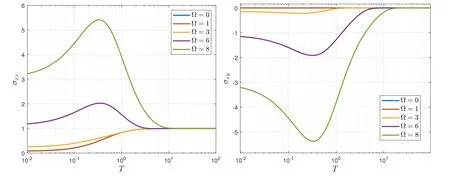
Figure 4.Temperature dependence of σxx (left) and σxy (right) under different shear strains ε=2 sinh(Ω 2)for W=X3 and k=5.Other parameters are fixed to be ρ=β=1.

Figure 5.Temperature dependence of σa (left) and σb (right) under different shear strains ε=2 sinh(Ω 2)for W=X3 and k=5.We choose ρ=β=1.
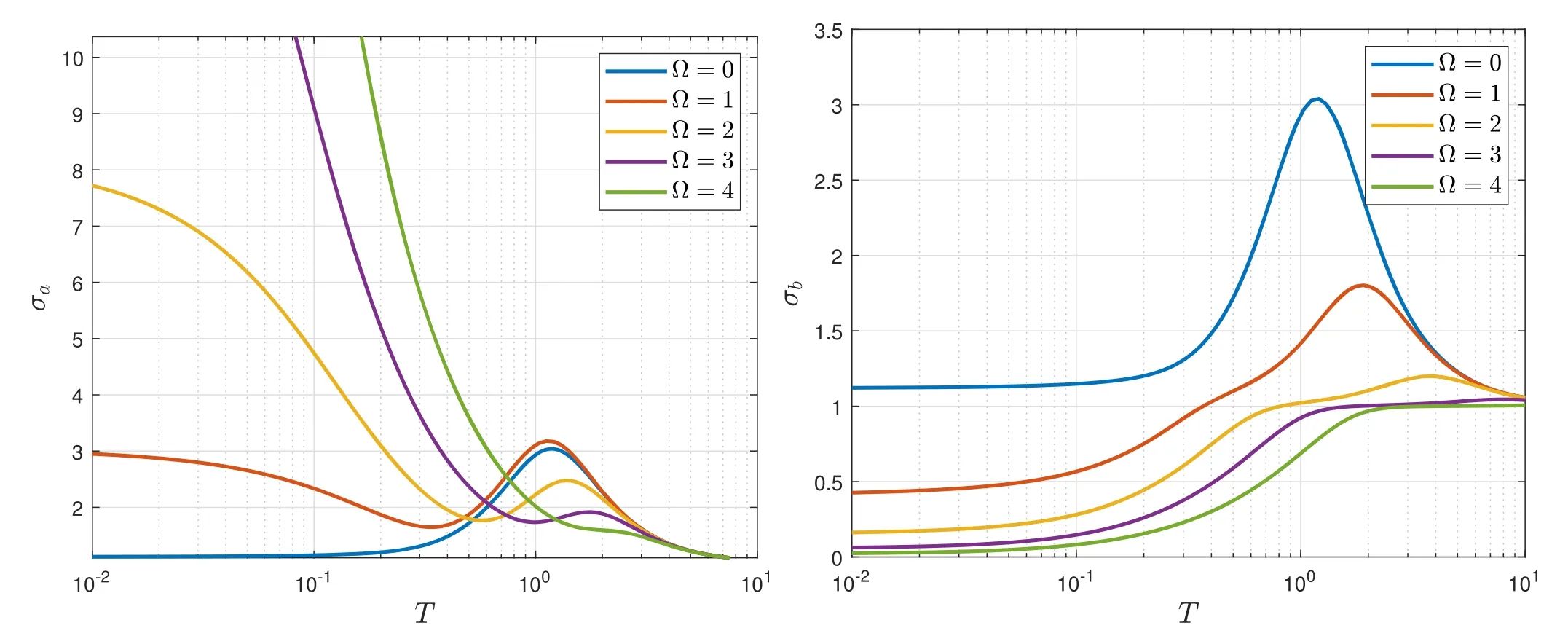
Figure 6.Temperature dependence of σa(left)and σb(right)under different shear strains at weak disorder k=0.1.We consider W=X3 and fix other parameters to be ρ=β=1.
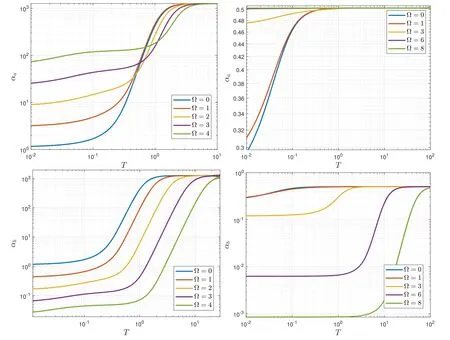
Figure 7.Thermoelectric coefficient with respect to temperature under different shear strains for W(X,Z)=X3.Left:the weak disorder case with k=0.1.Right: the strong disorder case with k=5.We choose other parameters as ρ=β=1.
Irrespective of the disorder parameterk,alongebaxis,αb=αxx+αxydrops more rapidly in temperature as the shear deformation is increased.At low temperature limit,αbapproaches a finite constant which,at large strain,decreases by increasing the shear deformation.In contrast,the thermoelectric coefficient αa=αxx-αxyalongeadirection becomes more and more insensitive to the temperature by increasing the shear strain.Moreover,its low temperature value increases with the applied strain.Remarkably,the low temperature value of αbcan be sufficiently small,yielding a good thermoelectric insulator driven by shear deformation.
5.3.Thermal conductivity
The thermal conductivity along the principal axes with applied strain is presented in figure 8.Similar to α,for both weak and strong disorder cases,one finds thatalongebdirection drops more rapidly in temperature for large strain,while the one alongeabecomes less sensitive to the temperature.
Another interesting transport coefficient is the thermal conductivity k at zero electric current flow.One can obtain k from(1) that

A universal bound was conjectured for the ratio of the thermal conductivity k over the temperature,which reads [35]

whereC0is a non-zero finite constant.From the left panel of figure 9,one finds that kb/Tapproach a constant at low temperature limit.In the right panel,we showC0≡limT→0(kb/T)as a function of the shear deformation.It is clear that the thermal conductivity bound can be significantly lowered.By fitting the numerical data for Ω>5,one findsC0∝e-Ω/2∝1/ε where we have used(8).Thus,the violation of the thermal conductivity bound(35) can be driven by the shear deformation17The violation of the above bound was found in Horndeski’s theory where its Lagrangian contains terms that have more than two derivatives [43,44]..
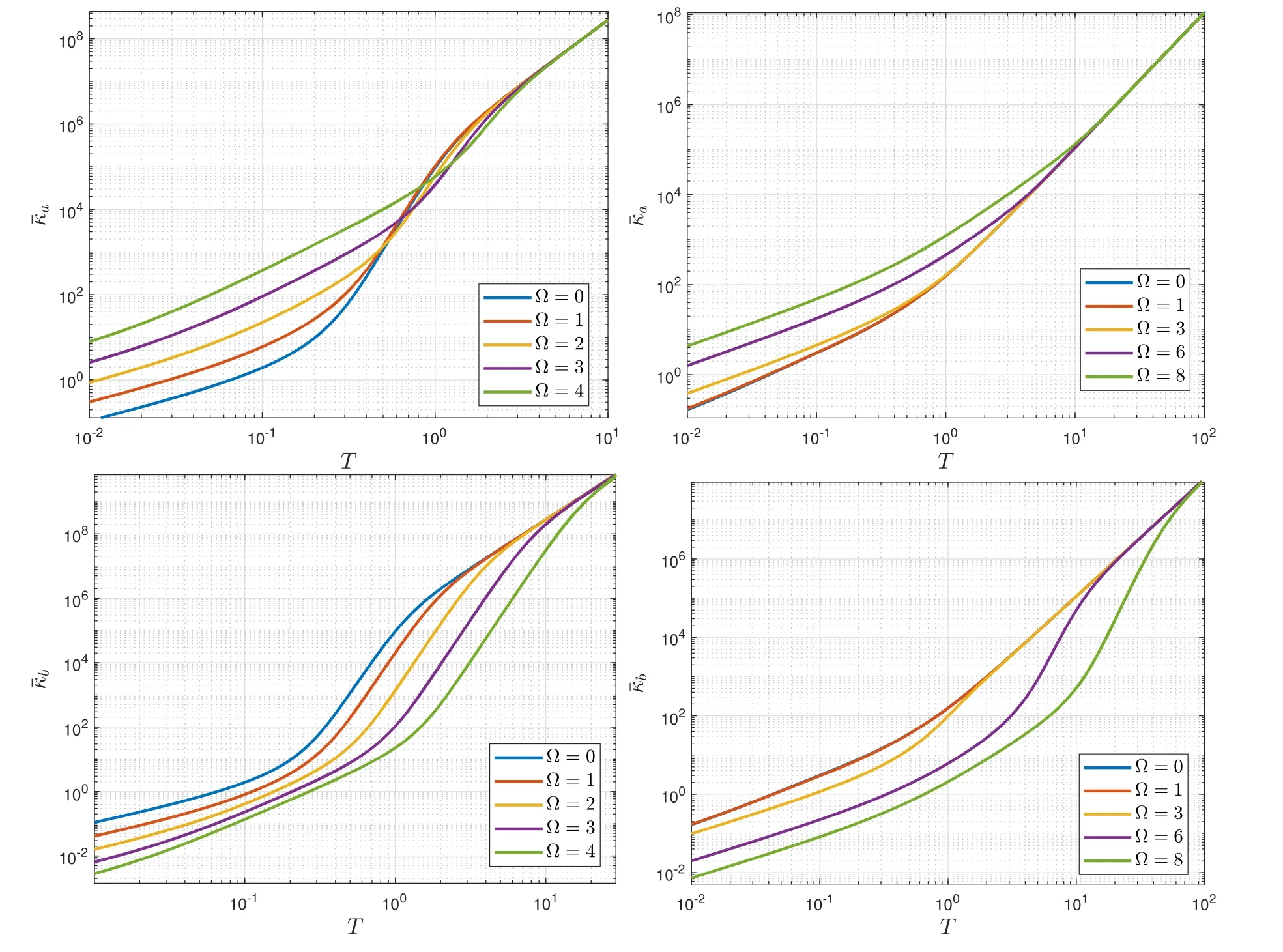
Figure 8.Thermal conductivity with respect to temperature under different shear strains for W(X,Z)=X3.Left:the weak disorder case with k=0.1.Right: the strong disorder case with k=5.We choose other parameters as ρ=β=1.

Figure 9.The ratio kb/T under different shear deformations for W(X, Z)=X3.Left: kb/T in function of temperature.Right: the low temperature limit of kb/T versus the shear deformation.The red dashed line corresponds to the fitted curve on the numerical data with Ω>5.We choose k=5 and ρ=β=1.
For the shear softening case,we find similar behaviors as the hardening one we have studied above.For illustration,we show the electric conductivity in the function of temperature by increasing the shear stain in figure 10.One can see that the unstrained state (the blue curve of figure 10) is an insulating phase.Then the strain engineering yields a good metallic phase alongeadirection,while an insulating phase alongeb.This feature is also confirmed in appendix B by considering the case under different charged densities.Compared to the shear hardening case,a much larger shear deformation ε is needed to change the conductivity significantly in the softening case.
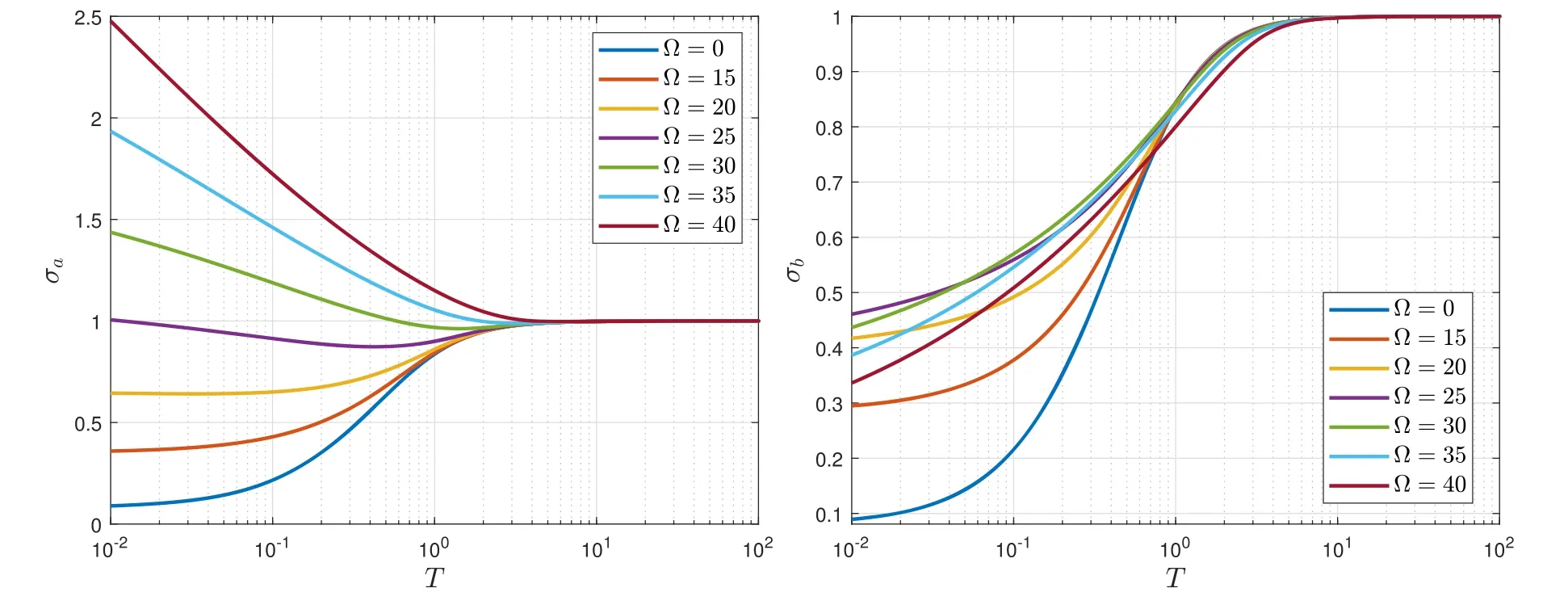
Figure 10.Temperature dependence of σa (left) and σb (right) under different shear strains for shear softening W (X ,Z)=.We have considered k=5 with ρ=β=1.
In our model,the strained conductivity alongeadirection is always larger than the one alongebdirection.As the strain parameter ε increases,the pressure difference between the two principal axes,i.e.ΔP=Pa-Pb=2Σ,becomes larger and larger.Meanwhile,the metallic behavior alongeaand the insulating behavior alongebbecome increasingly significant.Thus,the strain-induced transition seems to be closely related to pressure anisotropy.18The energy densityℇ as well as the pressureP defined by the holographic renormalization in appendix A can become negative at large k.This is a common feature of many simple linear axion models.Whenℇ is negative,one has |Pa|<|Pb| although Pa-Pb=2Σ>0.There might be some instability associated with the negative energy density that limits the application of these models,but such instability has never been found.In contrast to the commonly used renormalization in appendix A,one could consider a different holographic renormalization scheme to kill the issue of the negative energy density,see e.g.[45].Moreover,the anisotropy can be characterized by the electronic nematicityNin(31).In figure 11,we show the temperature dependence ofNand ΔP.One finds that bothNand ΔPincrease with the increase of shear strain.A better understanding of this shear-induced MIT transition requires further investigation.
6.Conclusion and discussion
In this work,we have initiated the study of transport properties of strongly coupled material under shear deformation using the holographic framework.It corresponds to strained black holes that trigger the spatial anisotropy spontaneously on the gravity side.As a building block,two sets of scalars have been introduced in our bulk theory,including φIthat give momentum dissipation and φIthat incorporate the mechanical deformation.The strain–stress curves have been constructed numerically (see figure 2).Depending on the potentialW(X,Z),the system can be shear hardening or softening.More complicated behavior of the strain in the function of stress can be obtained for an appropriate choice ofW.
We have obtained the thermoelectric transport subject to nonlinear mechanical deformation in terms of horizon data of the strained black holes,see(23)–(25).Interestingly,there are off-diagonal components of the conductivity tensors due to the shear strain.Moreover,they are all symmetric instead of antisymmetric,i.e.thus should not be anomalous Hall transport.We stress that timereversal symmetry is respected in our theory (henceα=¯α).We have argued that this feature is due to the anisotropy of our system under shear strain,see figure 1.More precisely,the angle between the coordinate system we used to compute the thermoelectric transport and the one defined by the principal axes is precisely given by π/4,irrespective of the strain strength.This particular value of the rotation angle explains the off-diagonal components of our conductivity tensors,see(30).
The holographic model admits a rich phenomenology even in the absence of strain.We have studied the regime of large shear deformations and how they affect thermoelectric transport.We have found the strain-induced MIT.More precisely,by increasing the shear strain,there will be a good insulating phase along one of the principal axes,and meanwhile a good metallic phase along the other principal axis of stress.This feature is found to be generic in our holographic model and is irrespective of the strength of disorder and charge density,see figures 5,6,10 and 13.It resembles a strong electronic nematicity in the system (see figure 11)associated with the spontaneous breaking of the rotational symmetry due to shear deformation.No similar features have been found in other holographic models with spatial anisotropy,see e.g.[46–48]19In contrast to our present case,in these models spatial anisotropy was introduced by turning on a source explicitly..Moreover,it was found that for a large class of black holes,the ratio of thermal conductivity to electric conductivity=Tσ¯has an upper bound≤ρ s22[49].We have explicitly checked many cases in our model and found no violation of the bond.On the other hand,the thermal conductivity bound [35] has been found to be violated for large shear deformation (see figure 9).
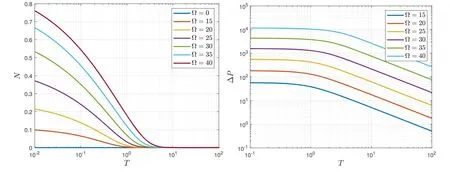
Figure 11.Temperature dependence of the electronic nematicity N (left) and the pressure anisotropy ΔP (right) under different shear deformation.We choose the same parameters as figure 10.
We have observed both the metallic and insulating phases along two principal axes for sufficiently large strain.It would be desirable to see if our theoretical results could be checked in lab experiments.To better understand this phenomenon,it will be helpful to find the IR fix point of the model.While our numerical computation suggests an AdS2geometry at finite deformation,the IR geometry at sufficiently large strain still asks for further investigation.We have limited ourselves to the pure shear deformation,and it will be interesting to consider the opposite scenario of a purely volumetric deformation in which the shear strain ε is taken to be zero.It would be interesting to extend the discussion to more general cases relevant to transport properties of holographic quantum matter,such as dispersion relations and other transport coefficients.In particular,there might be some instability of the large-strained state,which,in the bulk,is captured by the quasi-normal modes for the solutions(6)[50].We shall leave these questions to future work.
Acknowledgments
We thank Matteo Baggioli,Wei-Jia Li and Zhuo-Yu Xian for their useful comments and suggestions.This work was partially supported by the National Natural Science Foundation of China Grant Nos.12122513,12075298,11991052 and 12047503 and by the Chinese Academy of Sciences Project for Young Scientists in Basic Research YSBR-006.
Appendix A.Holographic renormalization
The bulk theory(2)in the main text involves both explicit and spontaneous translation symmetry breakings.It is necessary to consider the holographic renormalization procedure which will allow us to confirm the violation of the momentum and provide the precise definition of various observables in the dual field theory.In this appendix,we give more details on the holographic renormalization for our theory(2)and refer to[51,52,28]for more general discussions.To be specific,one needs to substitute the bulk configuration satisfying the equations of motion(3) into the action(2) and obtain the onshell actionSon.SinceSonis divergent,the renormalization is necessary to obtain the physical results.
It is convenient to work in the Fefferman–Graham (FG)coordinate

wherei,jlabel all boundary indices and ρ is the radial coordinate that should not be confused with the charge density in the main text.In the FG coordinate,the equations of motion(3) read
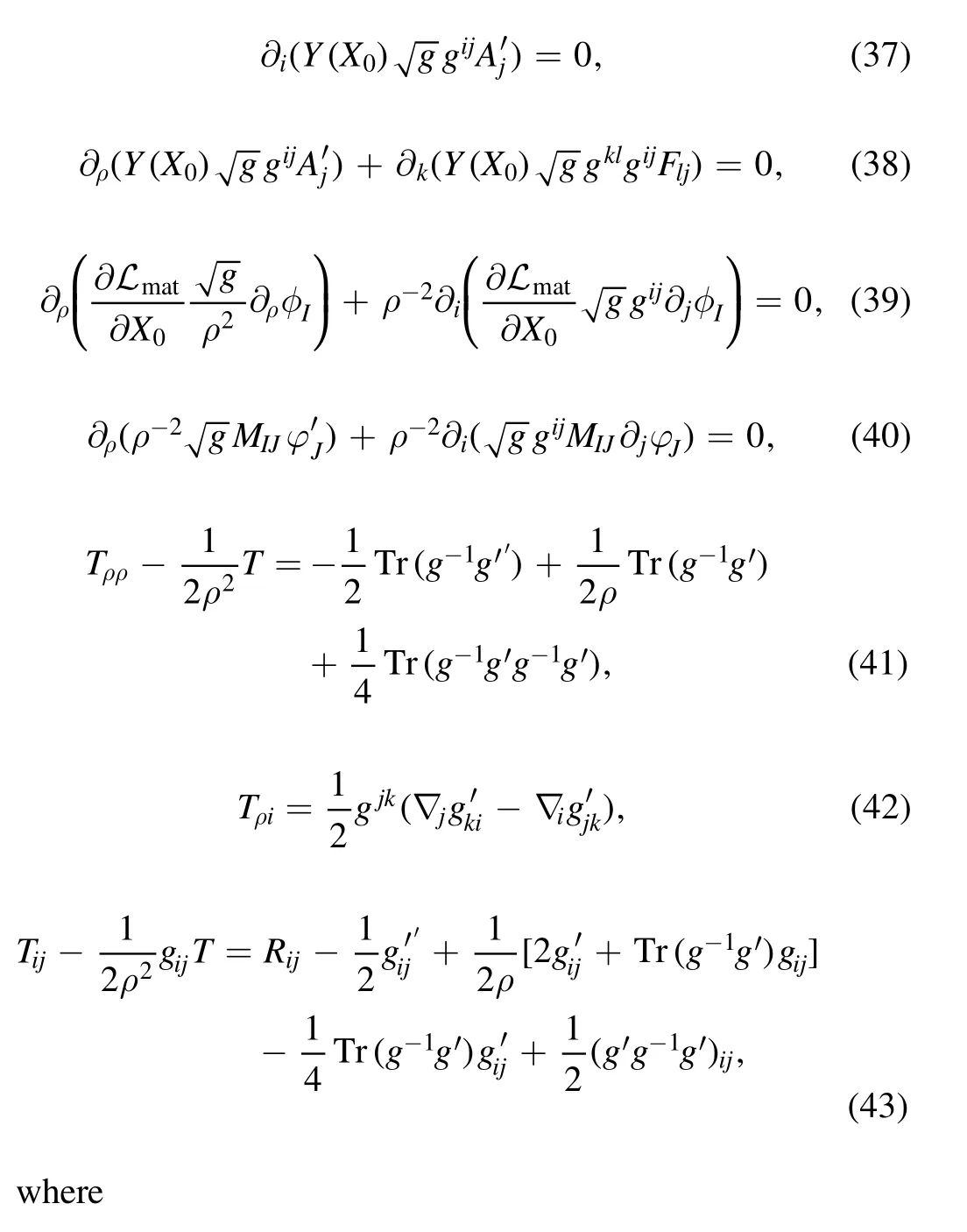
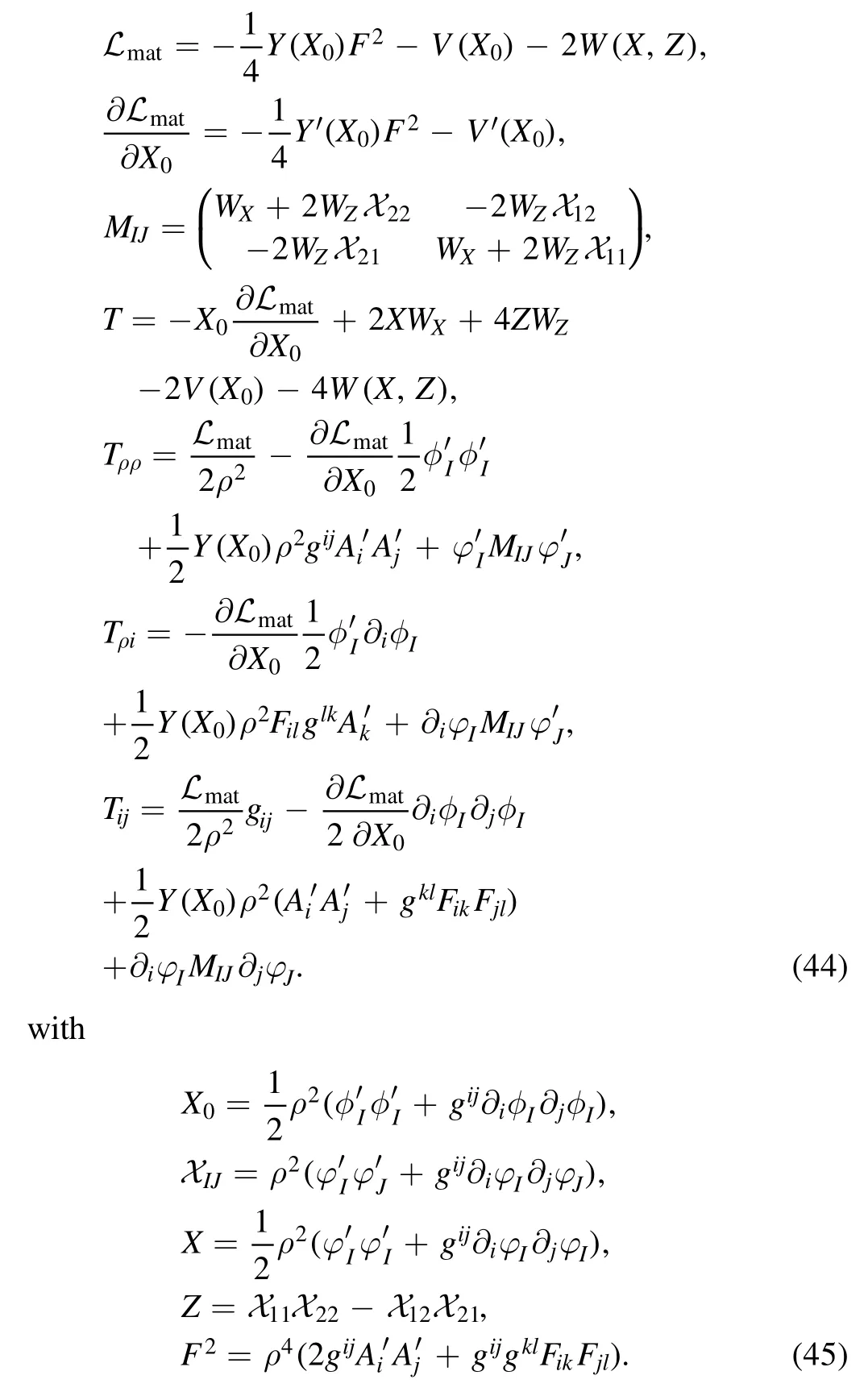
All indices here are raised and lowered withgijand the trace is taken by usinggij.The prime denotes the derivative with respect to ρ.
Near the AdS boundary ρ=0,the fields can be expanded in the power of ρ

For simplicity,we have consideredV(X0)=X0for explicit translation symmetry breaking for which the explicit symmetry breaking source isIn order to realizethe nonlinear mechanical deformation,we requireW∼ρ5or even faster such thatcorrespond to the vacuum expectation value of the scalar operators dual to the bulk axion fields φI,which matches the field theory description of mechanical deformation20We refer to[21,22,29]for a more detailed description and understanding of this mechanism..
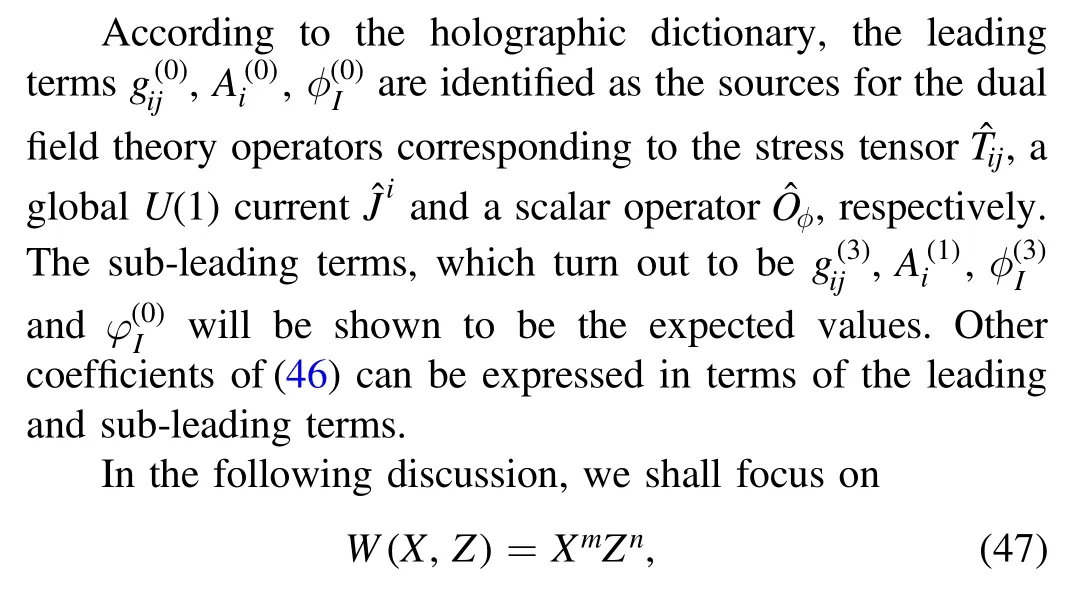
withmandnconstants.The consistency of a theory demands[53]

To ensure the presence of massless phonons in the absence of explicit translation symmetry breaking,one should further impose [53]

We can then obtain some useful relations by substituting the UV expansion(46) into(37)–(43).
• We obtain from the lowest order of(39) and(40) that
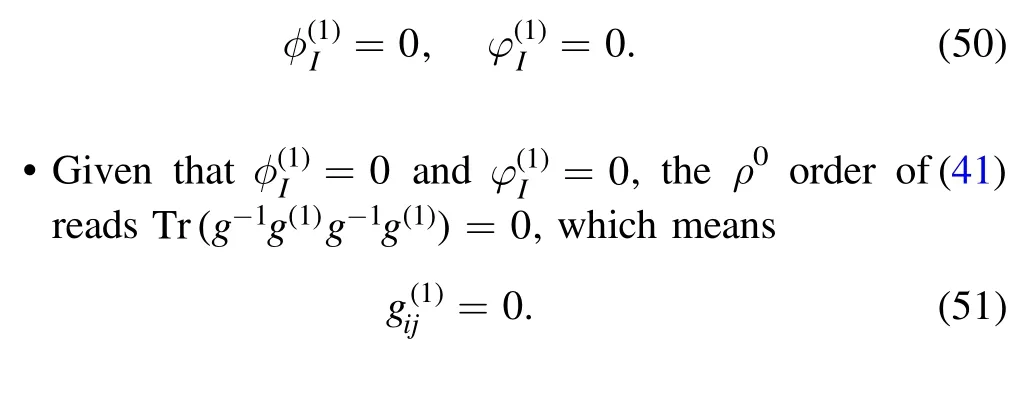
• Since we requireY(0)=1,the lowest order of(37) leads to

where ∇(0)is the covariant derivative associated with• The ρ-2order of(39) yields

• For the potentialW(X,Z)=XmZnwithm+2n>1,the lowest order of(40) yields
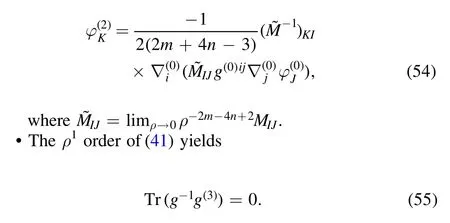
• The ρ2order of(42) gives

• The ρ0order of(43) yields

Substituting the field configurations that satisfy the equations of motion(3),we obtain the on-shell action that is divergent near the AdS boundary
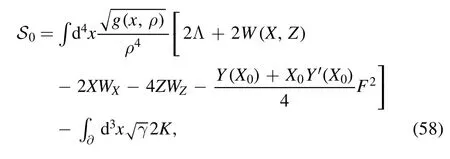
where we have added the Gibbons–Hawking boundary term for a well-defined Dirichlet variational principle.Here γ is the induced metric on the boundary andKis the trace of the extrinsic curvature21Denoting nμ tobe the outward pointing unitnormal to the boundary,we define the extrinsiccurvatureKμv=-(∇μ n v+∇v nμ)..We have also used the trace of Einstein’s equationR=4Λ-Tto eliminate the scalar curvature.Note that for the potentialW(X,Z)=XmZnsatisfying(48),there is no divergence from φI.
We now proceed to calculate the regularized action by introducing a UV cutoff at ρ=∊.
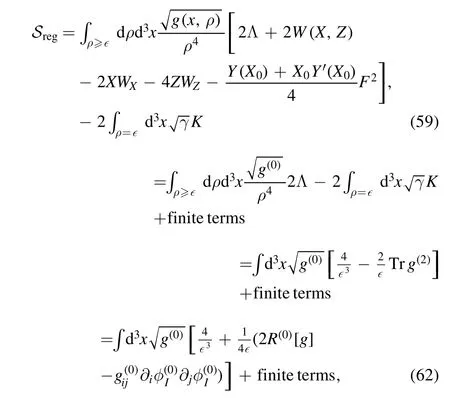
where we have used

The on-shell variation of the renormalized action(66)directly yields22Note that there is no contribution from φI since we have already set the source of φI to be vanishing.
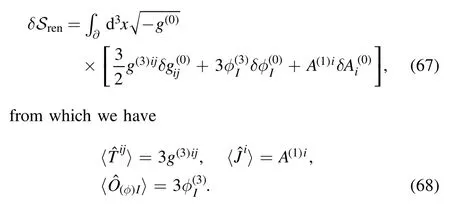
Moreover,using(52),(55) and(56),we obtain the following Ward identities:

So far,we have considered the EF coordinate(36).For our coordinate system(6) in the main text,we can directly obtain the general response of the boundary theory using the renormalized action(66).


Moreover,the transformation between the two coordinate systems is given by

One should obtain the same boundary expectation values using the above two approaches.From the last Ward identity(70),one can show that,at the linear level in the fluctuations,momentum in the dual field theory is not conserved due to the bulk profile of φI(6).
We now look at the background(6)and derive the stressenergy tensor〈Tij〉.In this case(6),we haveG[γ]ij=0 and
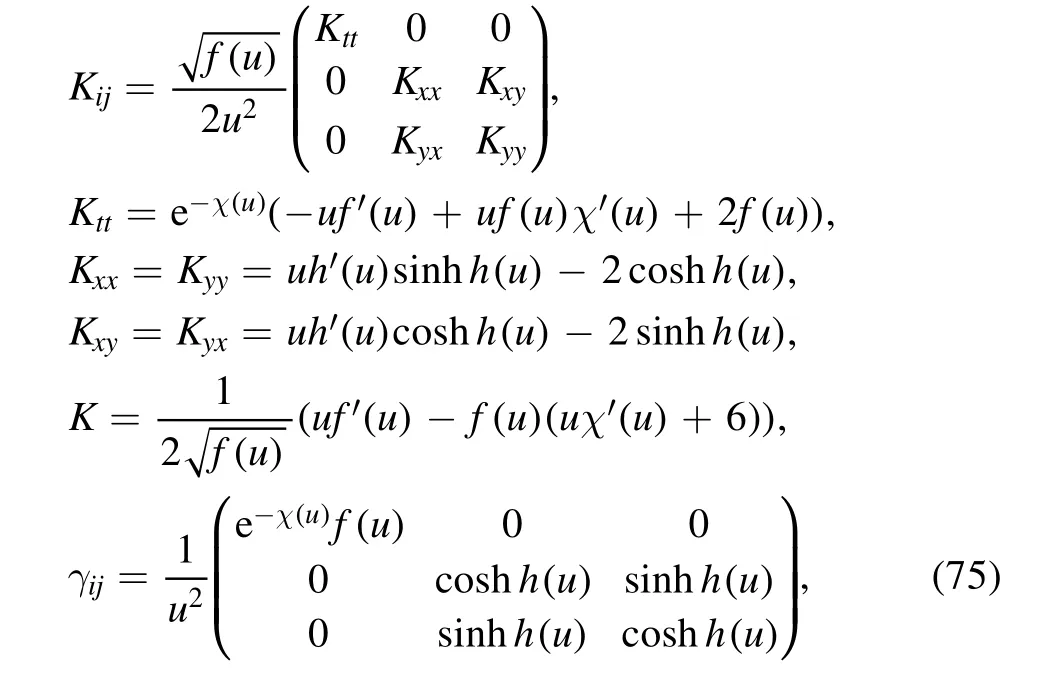
at a given hypersurface withufixed.Substituting the UV expansion(16) into(71) and taking the limitu→0,we can obtain the energy densityℇ,the isotropic pressureP and the shear stress Σ:

One immediately finds that ℇ=2P as required by the Ward identity(69).The stress tensor τ is then given by

By a simple change of reference frame which diagonalizes the above matrix,one has

Then,we can define the pressure anisotropy

which characterizes the anisotropy of our system under shear strain.
Appendix B.Strain effect on conductivity by dialing charge density
In order to confirm our findings in the main text,we consider the strain effect on electric conductivity by dialing the charge density.We focus on the potentialW=X3that corresponds to the shear hardening.
The electric conductivity in the presence of shear strain with different charge densities is shown in figure 12.One can see clearly that increasing the charge density will increase electric conductivity.For sufficiently large charge density,there is a metallic behavior above a particular temperature.When the charge density is small,one has an insulating behavior.Comparing the left panel to the right one,one finds that a metallic behavior along the eadirection will be enhanced or induced as the shear deformation is increased.
In order to see this feature more clearly,we plot the temperature dependence of the conductivity under different shear strains in figure 13.In the left panel,the unstrained case is an insulating phase.As the shear deformation is increased,while it remains an insulating behavior along eb,there induces a metallic behavior along ea.In the left panel,the unstrained case has a metallic behavior above a certain temperature.By increasing the shear deformation,the metallic behavior along eais enhanced,while the one along ebis suppressed and is replaced by an insulating phase for sufficiently large deformation.It is clear that strain engineering induces a good insulating phase along the principal axis eband a metallic phase along the other principal axis simultaneously,irrespective of the strength of charge density.

Figure 12.Electric conductivity with respect to temperature under different charge densities for W(X, Z)=X3.Left: the case at small shear deformation with Ω=0.1.Right: the one with large shear deformation Ω=5.We have fixed k=β=1.
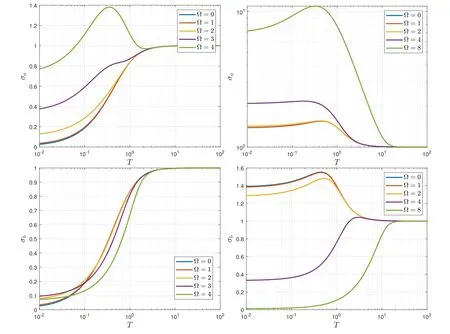
Figure 13.Electric conductivity in function of temperature under different shear strains for W(X,Z)=X3.Left:the case at charge density with ρ=0.1.Right: the one with large charge density ρ=20.We have fixed k=β=1.
杂志排行
Communications in Theoretical Physics的其它文章
- A numerical method to calculate dwell time for electron in semiconductor nanostructure
- Thermal Hall conductivity with sign change in the Heisenberg–Kitaev kagome magnet
- Dimensional crossover of a Rabi-coupled two-component Bose–Einstein condensate in an optical lattice
- Modification of laser-induced state in atomic attosecond transient absorption by the XUV pulse pair
- Optical forces on neutral atoms in the presence of fluctuating laser fields:numerical analysis
- High-sensitive refractive index sensing and excellent slow light based on tunable triple plasmon-induced transparency in monolayer graphene based metamaterial
